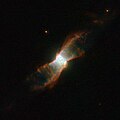Fichier:NGC 6881 HST.jpg
NGC_6881_HST.jpg (532 × 532 Pixel, Fichiersgréisst: 129 KB, MIME-Typ: image/jpeg)
Versiounen
Klickt op e bestëmmten Zäitpunkt fir déi respektiv Versioun vum Fichier ze kucken.
| Versioun vum | Miniaturbild | Dimensiounen | Benotzer | Bemierkung | |
|---|---|---|---|---|---|
| aktuell | 09:13, 31. Dez. 2019 |  | 532 × 532 (129 KB) | BevinKacon | actual size from source |
| 12:18, 12. Mäe. 2012 |  | 1.280 × 1.280 (266 KB) | Jmencisom |
Benotze vu Fichieren
Dës Säit benotzt dëse Fichier:
Globaalt Benotze vum Fichier
Dës aner Wikie benotzen dëse Fichier:
- Benotzt op ar.wikipedia.org
- Benotzt op az.wikipedia.org
- Benotzt op beta.wikiversity.org
- Benotzt op be.wikipedia.org
- Benotzt op bs.wikipedia.org
- Benotzt op ce.wikipedia.org
- Benotzt op de.wikipedia.org
- Benotzt op diq.wikipedia.org
- Benotzt op en.wikipedia.org
- Benotzt op en.wikiversity.org
- Benotzt op eo.wikipedia.org
- Benotzt op eu.wikipedia.org
- Benotzt op fa.wikipedia.org
- Benotzt op fr.wikipedia.org
- Benotzt op hr.wikipedia.org
- Benotzt op kk.wikipedia.org
- Benotzt op mk.wikipedia.org
- Benotzt op my.wikipedia.org
- Benotzt op nl.wikipedia.org
- Benotzt op pl.wikipedia.org
- Benotzt op pt.wikipedia.org
- Benotzt op ru.wikipedia.org
- Benotzt op sk.wikipedia.org
- Benotzt op sr.wikipedia.org
- Benotzt op tr.wikipedia.org
- Benotzt op tt.wikipedia.org
- Benotzt op uk.wikipedia.org
- Benotzt op uz.wikipedia.org
- Benotzt op www.wikidata.org

